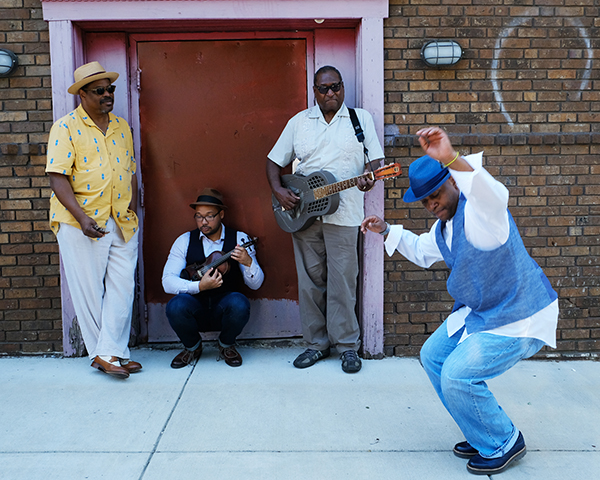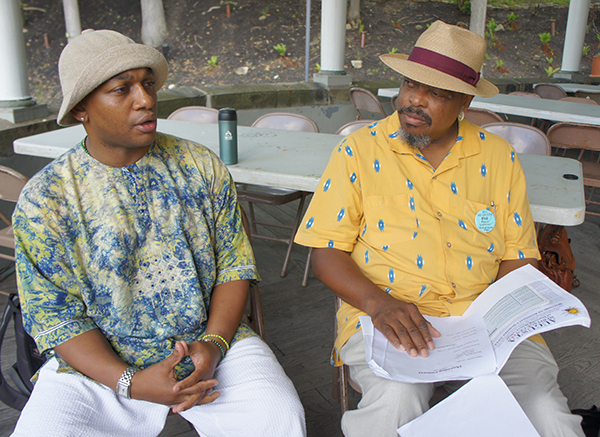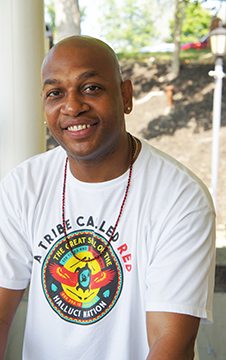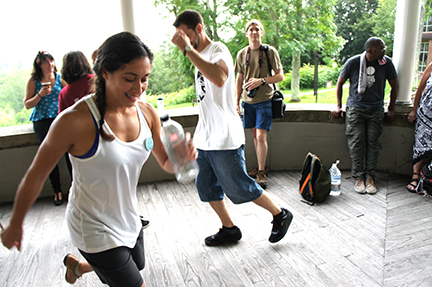Reuniting Dance with Acoustic Blues
By Frank Matheis 2020

In the book ‘Sweet Bitter Blues– Washington DC’s Homemade Blues’, by Phil Wiggins and Frank Matheis (University Press of Mississippi 2020), Phil Wiggins extensively wrote about his mission to reunite traditional acoustic blues with dance, the way it was originally done when people socialized, played blues and danced on Saturday evenings after a long week of work. Accordingly, in his ensemble he features dancer Junious Brickhouse as a regular bandmate. The result is a unique and exceptional performance that rejuvenates both the music and the accompanying dance.

Mr. Wiggins explained, “Junious brings the dance to the House Party ensemble, which fulfills one of my lifelong endeavors, to reconnect the Piedmont dancing with Piedmont music. The House Party ensemble pushes the energy and we try hard to work together to inject fire and the energy into the music. With Junious putting on a great dance show, it is wonderful to go on stage with them all, because not much can go wrong– all the ingredients are there. Junious became aware of me, and my music, through that great film that Eleanor Ellis produced called House Party. He is the director of Urban Artistry, a dance troupe out of Silver Spring, Maryland, through Clifford Murphy, who was the Maryland folklorist at the time. Since then we have become friends and he and his troupe often dance with us, including in the House Party.

Just about every note of music that I ever played in my life has been dance music, but rarely has it ever been presented as that. Most places that I go to perform, people are sitting on their butts and listening. It’s really not what the music was made for. This music was the soundtrack for parties. It was dance. So right about the same time as I had wanted to bring dance back where it belonged, I had the good fortune of two dancers coming into my life.
It gives me a great deal of satisfaction to see the dancers in action. For example, I invited Junious to the Augusta Blues Week in 2016 and 2017. He brought the entire dance troupe and they had so much fun and sparked up the entire event…When I first started going to Augusta, John Jackson and Cora Jackson were there. But no one ever thought to call on Cora, because she used to teach young girls in her community dancing, to invite her or to ask her to join in and show people the dances that came from that community. It was a huge missed opportunity. When I met Junious, I knew it was the right time to do this because he was the right person to do it… He collected an amazing group of young people that really just got that spirit and understood that and were hungry for it. He brought that energy and generosity and sensibility to Augusta, and it was amazing. We hope to keep building on it. And he brought Willette Hinton, who is the son of Algia Mae, who doesn’t dance anymore, and John Dee Holeman, who doesn’t dance anymore. Willette inherited those traditions and he is willing to come out and share it with young people. It’s just amazing.” Phil Wiggins
thecountryblues.com caught up with the dancer, who lives in Adelphi, Maryland, in the middle of the 2020 pandemic lockdown via telephone from Chicago, Illinois, on July 27, 2020:
FM: You are a dancer and a director of a dance troupe, involved in various forms of dance in the African American tradition. You also have a very interesting background, including military service. Will you talk about that?
JB: I joined the military in 1991 and served for 10 years in the U.S. Army. I went to basic training in Fort Jackson, South Carolina. I went to advanced training at Fort Lee, Virginia. My job was a 92 Yankee – that was supply specialist. I would go to these stations at Fort Sill, Oklahoma, Fort Gordon in Georgia, and I would spend the last four years of my career on NATO assignments in Europe. I deployed to Bosnia Herzegovina. I also served in Kosovo during that conflict. And as a defense contractor I served also in many combat areas, primarily Afghanistan.
FM: Junious, right now are you are the director of the Urban Artistry dance troupe. Please tell us about your role in that.
JB: In 2005, I moved to Washington, D.C. after spending about eight years abroad in Europe, partially in the military and as a defense contractor, and as an artist educator in my spare time. Upon returning home, I wanted to create a community of dancers who wanted to take a deep dive with me to find out about dance movement in the African American Diaspora. I wanted to document and teach it, if possible, and serve as educator. But I wanted to make it accessible. In a most dance companies you have to be famous, you have to know someone, you have to be really talented. I wanted to create a place where you don’t have to be that, so the drive was education, to educate, teach and train dance. It was a pleasure for me to find a handful of people who were interested in this mission. Since then I served as the executive director of the Urban Artistry Dance Troupe. We have been doing our best to not only perform movements that come from African American communities, but also to share that experience with other people and create an institution where people can learn responsibly –and hopefully let that become a tradition of theirs and not just “Oh, I dance for recreation.” Dancing becomes a way to express cultural identity. I love it. It’s my community work, and that has inspired me to work internationally. I also direct a a cultural diplomacy program, called Next Level. It’s a hip-hop diplomacy program that’s funded by the U.S State Department, the Department of Education and Cultural Affairs, and also administered by Meridian International Center and the University of North Carolina at Chapel Hill. In this program that I direct, we take several artists and to different countries across the world. Those artists are subject-matter experts and educators and also artists who are doing beat-making, DJ-ing, emceeing, dancing, aerosol arts and beat-boxing. We go to these countries and for two weeks we conduct classes on art forms, but also on conflict transformation and entrepreneurship.

FM: How did it all start for you?
JB: I started dancing in 1977. I can remember my mom teaching my sister and me different funk moves, different social dances for funk music. She taught us how to lock and to do popping, the breakdown and the funky robot –all these social dances. I grew up dancing. The goal was to be well rounded as a mover. It was never to have a specialty. I grew up as a kid in the ‘80s, so I learned hip-hop culture. I grew up in that culture. Hip-hop is a funk manifestation, those things were heavily connected. But the well of information that we pulled from was associated with tap –buck dancing. That was in our minds, the dance of our grandparents. We saw ourselves in their light.
But, as far as like learning how to dance to blues music, there was nowhere to get that information. For us, it was just about enjoying the African American roots of blues music and having a movement experience. I think that’s important to say because I think often people look at people here, particularly the country blues, and they automatically think of buck dancing as a platform. But, if we think broadly and openly about it, particularly in African American communities, movement was movement. And even (buck dancers) that we worked with – like John Dee Holman and Williette Hinton, and the great Algia Mae Hinton – may she rest in peace – they just referred to themselves as “dancers”. They didn’t say, “I’m this kind of dancer.” I think they widely saw themselves as part of dance movement in the African Diaspora. And I kind of feel that way too. When I’m dancing to blues music, I’m trying to create a timeline of sorts. I’m trying to remember all the movement that I’ve experienced as a black man in the United States. I’m mixing it up. I feel like that’s authentic for me, and that surpasses whatever the genre wants to do – the genre of music wants to do. Because as the years go by, I’m sure people will have different ideas about how to dance to this music as the music changes. I want to be connected to all the ways that you can dance to blues.
FM: So, when you hear any kind of music, whether it’s blues or whatever it may be, and before you dance, do you tune into the whole tonality? How do you decide what you’re going to do artistically?
JB: That’s a good question. For me, when I’m improvising. I’m literally trying to feel the music and each instrument that’s playing, whether it’s a guitar or a fiddle, a banjo, harmonica or voice – I’m moving to an instrument and I try to put movement on each instrument. It’s syncopated, an intentional form of playing with it. I’m trying to be the music and to create that visual for people that I’m sharing the space with.
With the blues it’s a different experience for me than with like hip-hop or funk or house music. I really feel an ancestral connection with the blues. It’s difficult to explain. I hear this music and I’m motivated. It’s like I can almost feel an ancestor singing this song or playing this song. I’m enjoying that. I’m currently surrounded by legends in this music business and also up and coming, amazing artists. For me it’s a celebration every time. I’m so happy to have the experience to enjoy this music.
FM: So let’s talk a little bit about the role of dance in the African American community from the early time of slavery up until now. I’m asking you just about feelings more than history. Up until today there have been certain specific approaches to dance in the African American community and the blues goes back by now almost 100 years. The music that preceded it goes back hundreds more. As you are now on stage with people that are playing that deep roots music that transcends back at least 100 years or more, and how do you tie all that whole dancing together the same way that blues maybe ties the music together?
JB: I feel that when we think about the movement and the music that comes out of African American communities, let’s say for the last 100 years then, we’re talking about a wide range of experiences. I think it’s important to say this, but African Americans are not a monolith. There are so many different cultures within our community. Some of that is ancestral, right? We don’t all come from the same country. Our ancestors are from all across the continent. I think there are some things that we understand differently, and we hear the music differently. When I think about movement, I think about everything from ring shouts to tap to buck dancing, to flash, to jazz, to popping, locking, whack and folk. You know even to break dancing. For me it’s like having a dictionary. The music helps me to articulate what it is that I want to say artistically. I reach into this well and I pull something out, and I see how I can match it to the music, and I see how it makes me feel and how I’m able to find a common language with others.
I feel that we haven’t even scraped the surface of all of these different perspectives. There’s different interpretations of what is blues and what is not blues. It’s communal. If we weren’t COVID – if I were to go to a blues club here in Chicago, that’s going to be different than if I go to Hillsboro, North Carolina. If you speak about movement this way, people in different communities all across this country have a way of interpreting music. If we could write that all down and document that, could you imagine what the canon of movement would look like? That’s part of my work. I am not just trying to do the dances that have been done, but actually finding how people are feeling about what they can create, what they can add to the music. As the music evolves and as people start to participate in different ways, I feel like dance movement will too. I hope to be on the right side of history when that happens.
FM: You are a regular dancer with the National Heritage Fellow, blues harmonica ace and teacher Phil Wiggins and the Blues House Party, performing to deep roots acoustic blues. Do you want to talk about that experience?

JB: I initially met Phil because we were both complaining about why there’s no dancing being done to blues music, which was originally what the music was meant for. I met Phil and we actually did a master/apprentice program with the Maryland State Arts Council and Maryland Traditions. We just became really close friends and I learned a lot from him. Phil introduced me to many blues musicians and helped me put faces and names to a lot of things I was hearing in the blues. He gave me the drive to want to see the harmonica as something more than just the sound that reminded me of growing up in Virginia. He gave me purpose with the instrument, and I started to play more, because I was spending more time with the music and with Phil. I was starting to dance more. It just changed my life. A lot of the people that I had been reading about, like John Dee Holman and Algia Mae Hinton became friends. We started working together and learning about them and their families and the people behind the talent. Phil was the reason that I was able to do that responsibly. I think that’s what was key about our relationship. He helped me remember that people aren’t research. People are people and making lasting bonds is more important than some strange outcome, or some recording that we can put on YouTube to make everybody think that we’re really close friends with somebody who is great. I have Phil to thank for a lot, and I’m glad that he’s in my life.
FM: Junious, what do you consider the most important thing you want the world to know about you?
JB: I think the most important thing I want people to know about me is that there’s so much that goes into being an artist and it’s not always an easy road. For those of us who are sometimes marginalized, who don’t have certain privileges, our art forms are part of our legacy, what we leave behind, how people remember us. It offers us this larger and broader conversation about critical heritage and what that means. I want people to know that I care about people. I care about art and I feel like we have the responsibility in today’s age to get it right. It represents my people and their contributions to this music and to dance movement. I’m a warrior for that, and that’s the journey I’m on.
I appreciate you making time to interview me. I think if there’s anything that I could leave behind is I want to say to people and encourage people to continue to hear and listen to the whispers in our community, the people with the talent that aren’t being seen and aren’t necessarily being celebrated and centered – look in your communities and find out who’s young and also who’s old and who’s doing blues and encourage it and help provide spaces so they can exist – and not always through a purist lens. I think we need to consider what tradition can be and what it can mean to people also 20 years from now. I just want to encourage people to do that. Let’s keep this thing going. The blues is not a thing of the past. It is current. It has music, but it also has dance movement. It’s also comprised of very beautiful people, and we need to center them.
END